|
|
San Sebastiano
|
|
|
History The first church on this site was an oratory to 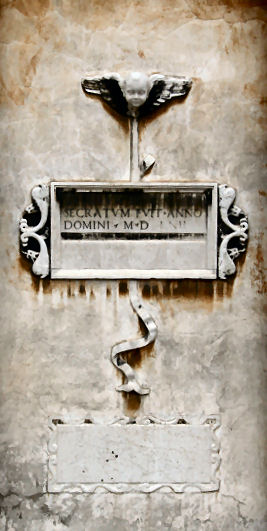 Santa Maria Assunta,
founded in 1396 by the Girolamini - the order of the
Hermits of Saint Jerome. It was rebuilt in 1455 and again between 1506 and
1548, when it was replaced by a bigger church also
dedicated to the Virgin, but to Saint Sebastian too, in thanksgiving for his deliverance of the local population from the plague of 1464.
Both saints feature in the decoration of the church.
The building of this, the current church and its monastery
saw the church's façade switched from facing the Campazzo San Sebastiano
(as seen in De Barbari's map of 1500) to the current arrangement facing
the canal. This work was carried out by Antonio Abbondi, known as Scarpagnino,
and it was his last built church. Santa Maria Assunta,
founded in 1396 by the Girolamini - the order of the
Hermits of Saint Jerome. It was rebuilt in 1455 and again between 1506 and
1548, when it was replaced by a bigger church also
dedicated to the Virgin, but to Saint Sebastian too, in thanksgiving for his deliverance of the local population from the plague of 1464.
Both saints feature in the decoration of the church.
The building of this, the current church and its monastery
saw the church's façade switched from facing the Campazzo San Sebastiano
(as seen in De Barbari's map of 1500) to the current arrangement facing
the canal. This work was carried out by Antonio Abbondi, known as Scarpagnino,
and it was his last built church. The church and the convent next door were suppressed in 1810 by Napoleon and the convent was partially demolished before being rebuilt in 1856. It now houses the University of Venice's department of literature and philosophy. Extensive restoration work on Veronese's ceiling paintings and framework in 1832-33 and cleaning in 1962. In more recent years more extensive restoration work has seen the church a place of scaffolding and noise for most of the noughties. The church The façade, the final part to be completed, is dominated by the two pairs of Corinthian columns at the ends on each level, which support a large tympanum with statues of Saint Jerome, Saint Catherine of Alexandria and, in the middle, Saint Sebastian. The interior and art No aisles but three good-size altar niches either side, under a nun's gallery which wraps around the nave, also forming a narthex at the back. None of the nave chapels have first-rate altarpieces, and only one is by Veronese. What they do have is cards telling who the rich American was who stumped up the cash. The ceasing of the protrusion of this block of altar niches at the back forms a transept of sorts, with the organ and entrance on the left and the monumental tomb of on the right. A deep domed presbytery is flanked by two deep side chapels As you go to the Madonna dell’Orto or the Scuola di San Rocco for Tintoretto and to San Giorgio degli Schiavoni for Carpaccio, this is where you come for Paolo Veronese. It was his parish church, and doubtful tradition has it that he found refuge in the monastery after killing a love rival. He began decorating it at the age of 30, working here from 1555 to 1581. His commission came from the then prior here, Bernardo Torlioni, who was also originally from Verona. Veronese died in 1588 and was buried here - his tombstone is in the floor in front of the Lando Chapel, in the left transept, with a bust on the wall above. He is buried next to his brother Benedetto Caliari, also a painter, who helped out, completing the work in the nave in less than a year after Paolo's death. Almost all of the decoration of the interior is the work of Veronese and his studio - the paintings around the choir and on the ceiling and the organ doors, the frescoed walls, featuring figures and architecture, and the sacristy, which is earlier work. The nave ceiling, begun by Veronese in 1556, just four weeks after he finished in the sacristy, shows scenes from the Life of Esther, and on the gallery walls the Trial and Martyrdom of Saint Sebastian. The central panel of The Coronation of Esther (see right) echoes the Coronation of the Virgin panel that Veronese had painted for the sacristy the year before, Esther being seen as the Old Testament prototype of Mary. Restoration of these panels took place in the Abbazia della Misericordia, next to Santa Maria Valverde from 2008. The trompe l'oeil painting here blends unnervingly smoothly with the actual architecture, which had been finished only a few years before. You get the impression that the church was built specifically to house the trompe l'oeil vistas and the combination of art, sculpture and architecture is all-over seamless. Veronese had trained as a stonecutter too, that being his father's profession, and designed the altar, along with the organ and the choir stalls. The high altarpiece was commissioned from Veronese by the Cornaro family, including Caterina. It depicts Saints Sebastian with Saints John the Baptist, Francis, Peter, Elizabeth, Catherine and the Virgin in Glory with Musician Angels. Ridolfi says that Saint Francis is a portrait of Veronese's patron here, Bernardo Torlioni. On the side walls of the sanctuary are panels of Saints Mark and Marcellian Led to Martyrdom and The Martyrdom of of Saint Sebastian, said to have been painted by Veronese to replace damaged frescoes of the same subjects. There's a smoky late Saint Nicholas of Bari by Titian, painted when he was 86, on the right as you enter. Also works by Palma Giovane and an 18th-century painter called Federico Bencovich. The sacristy Through a door on the left under the organ, contains Veronese's first work here from 1555 (see photo right). His canvas ceiling panels depict the Coronation of the Virgin in the centre, with four ovals depicting the Four Evangelists surrounding it. There are putti in the four tondi at the corners (said by Ridolfi to be the work of pupils), and painting onto the woodwork of the ceiling, depicting Old Testament scenes, that have lasted less well than the canvas panels. Before he began there were already works here by artists from Verona of an earlier generation, including a Crucifixion by Domenico Brusasorci and works by Bonifacio de' Pitati.
Lost art
Opening times |
|
|
|
Interior
|
|
|
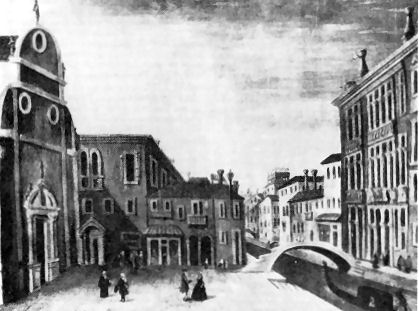 History History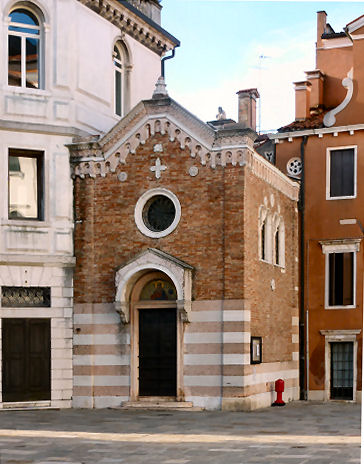 The original church of San Vio (dedicated to Saint Vitus and his partner in martyrdom Saint Modestus) was built in 912 by the Vido and Balbi families. It was rebuilt in the five years following Bajamonte Tiepolo's unsuccessful conspiracy against the republic on the 15th June 1310, using masonry from Tiepolo's demolished palazzo at Sant'Agostin - the door to the palazzo becoming the door to the church (see print left). The doge and signoria would visit the church annually on that day, which is also Saint Vitus's day, to commemorate Tiepolo's defeat. In 1354 the small campo in front of the church was extended down to the Grand Canal, by demolishing the Tagliapetra palazzo, so that the dignitaries would have a grander approach. The church had seven altars, under one of which was placed the miraculously preserved (and miracle-working) body of the Contessa Tagliapetra. The was a cupola with frescoes by Girolamo Brusaferro and altarpieces that were school-of Veronese and Giovanni Bellini. Restoration work in 1745 found the floor of the original church, 8ft below the then floor level. The church was closed in 1808 and declared dangerous and demolished in July 1813. Fragments from the church were used in the building of the current oratory which was built nearby by Gaspare Biondetti Crovato, to a design by Giovanni Pividor and opened in 1865. Fragments from the house of Bajamonte Tiepolo were reused again, around the door. It is now a private residence, belonging to one Piero Pinto at last report, and closed to the public. A banner on the wall of the current building in November 2021 announced maintenance work on the interior and gave the client’s name as Robert Holmes Tuttle. who might well be the current owner. Rosalba Carriera's tomb The original church was the burial place of painter Rosalba Carriera and her sister Giovanna, who both lived nearby. The oratory had a stone plaque on the wall engraved with the words Rosalba Carriera Pittrice 1757 but this is now gone. Vaporetto Accademia map |
||
|
History Founded perhaps in the 10th century, this church was first mentioned in a document of 1081. It was rebuilt after a fire in 1105, but much of the original nave's brickwork remains. Reconsecrated in 1321, with interior decoration work in 1604 and 1670 by Lodovico Bruzzoni, and more restoration work in 1733. Suppression by the French followed in 1810 and the church was stripped of its art and furnishings. After a time being used as a warehouse for firewood and coal the church was acquired in 1839 by Antonangelo and Marcantonio Cavanis. Restoration work on the interior and façade followed and the church reopened in 1872 as an oratory for the nearby Educational Institute of the Cavanis. More restoration work in 1939. Art highlight Reportedly the only remaining art of note is a Guardian Angel by Lattanzio Querena. Lost art The Coronation of the Virgin by Michele Giambono (see below right), now in the Accademia, was commissioned in 1447 by Giovanni Dotto for the high altar here. The commission came with the stipulation that the work be finished in a year and be an exact copy of the Coronation of the Virgin by Antonio Vivarini and Giovanni d'Alemagna in San Pantalon. One scholar has argued that this Accademia Coronation is also the work of Antonio Vivarini and Giovanni d’Alemagna and not Giambono's work for this church at all. Giambono also designed mosaics - he signed the mosaic of the architecture-dominated Presentation of Mary in the Temple in the Mascoli chapel in San Marco, amongst other scenes from the life of the Virgin, the creation of which he was also involved with. The inspiration for both of these Coronations has been identified as the version painted by Guariento di Arpa in the Palazzo Ducale 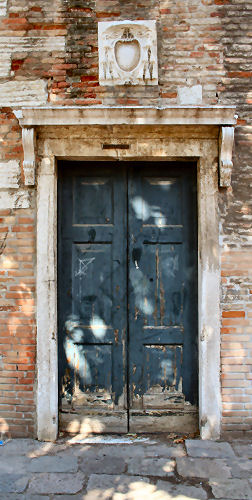 Campanile Was also 12th-century (see map below) but demolished in 1837-38. The lower part still stands, though, topped by a three-arched bell tower. Opening times Only the door to the little chapel to the left of the main entrance ever seems to be open. It is said to host services on weekdays at 7.30. Vaporetto Zattere map
|
|
|
|
|
||
|
History One of the oldest churches in Venice, originally built by a merchant called Geniano Busignaco in 836 and consecrated in 853, during the reign of doge Pietro Tradonico. The first certain documentation for this first church however is 1108. It was said to have been a three-aisled basilica with a gold-covered apse of mosaics and to have had a dome supported by four marble columns. By the time of De Barbari's map there is no dome. The current church dates from the 1687 rebuilding by Giovanni Battista Lambranzi, the parish priest, also responsible for the nearby, and similarly plain-fronted, church of Le Eremite. Saint Margaret of Antioch was a saint very popular in the East, as was Saint Pantaleon who has a church very nearby. The church was suppressed in 1808, becoming a tobacco factory and then a storehouse for marble from the other suppressed churches. From 1882 the building was used as a Protestant church, then the studio of sculptor Luigi Borro, and then a cinema. In the early 1990s it was converted by architect Luciano Gemin into a lecture hall for Venice University's architecture faculty. Peering through the door you'll see a plain space with the look of a conference centre, the pews having been replaced by rows of stacking chairs. But interior photos show considerable conversion to a theatre (see right), and that the ceiling painting The Martyrdom of Saint Margaret, attributed to Antonio Zanchi, is still in place. Various carvings from the church have been set into the campanile stump and the walls of the adjacent house. 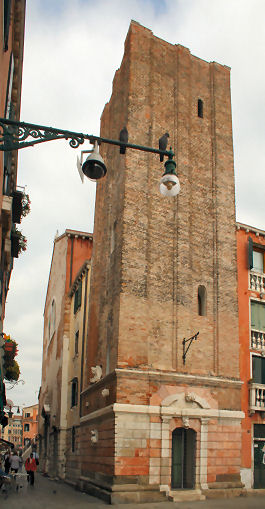 Campanile In 1808 the upper part of the campanile was demolished as it was unsafe, leaving a 46ft stump for use as accomodation. The painting below, by Gabriel Bella, shows the campanile intact in the late-18th century, but looking a bit wonky.
Lost art
|
|
|
|
History Veronica Franco, we are told, in repentance for her sensual ways. and with the help of devout nobles, in 1578 established a shelter to temporarily house elderly and destitute prostitutes and adulterers separated from their spouses, called the Pie Case del Soccorso. The aim was to prepare the women for work, marriage or a vocation. Following the decision to also help and house their husbands larger premises were needed, and found in the parish of San Raffaele, completed by Simon Sorella, and occupied in 1581. Expansion followed and an oratory completed in 1594 and consecrated by Lorenzo Prezzato, Bishop of Chioggia in 1609 to the Virgin of the Assumption. The complex was restored in the mid-1700s. The institute lasted until 1807 when the women were moved to Santa Maria delle Penitenti and the oratory closed. The disused complex was bought by the priest of the Carmini church, called D. Marco Battagia, in 1860 to become a hospice for abandoned girls and later a school, but plans to reopen the oratory for worship came to nothing. Much work on the complex in the 19th and 20th centuries becoming university accommodation. The church housed a temporary Biennale exhibition in 2003 but following work in the next decade the complex is now luxury apartments. In 2013 the church was observed to now be a bare box with some remaining stucco work. 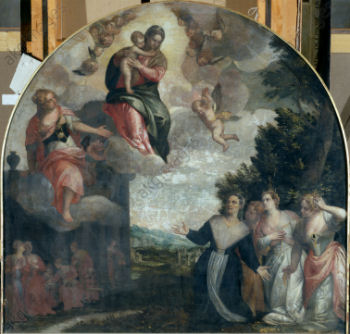 Lost art Lost artAn altarpiece of The Foundation of the Casa del Soccorso from 1595 by Carletto Caliari, the son of Paolo Veronese (see right), is now in the Accademia. Two by Naitlingher and others by Giuseppe Enzo have been reported. |
|
|
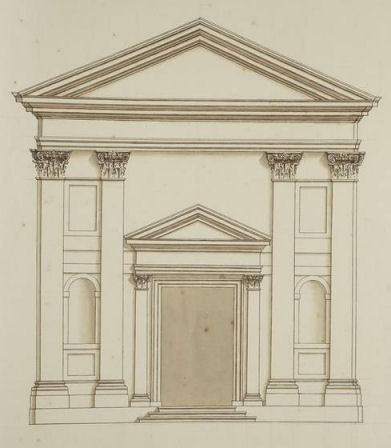 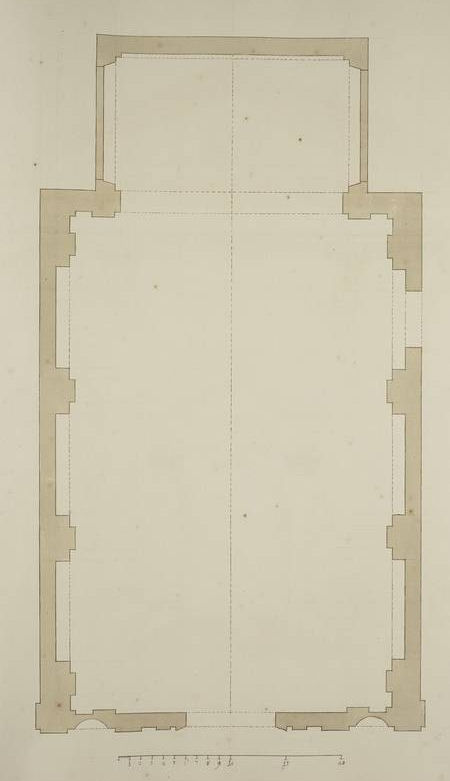
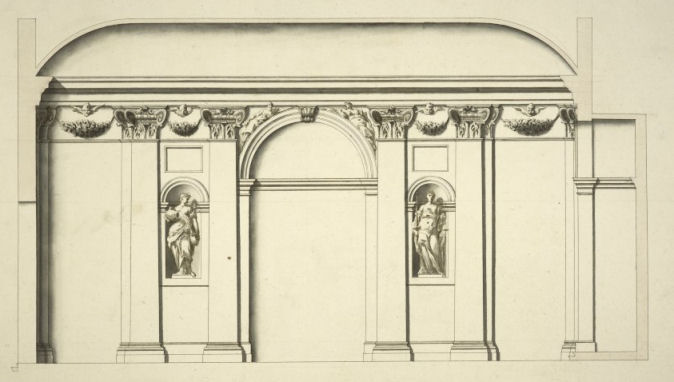 A plan and elevations by Visentini and his studio |
||
|
History The first documented church and convent on this site were founded in 1134 by an Augustinian order of friars from Ravenna, although it is said there was a wooden church on the site before this, erected to house a miracle-working Virgin. The 12th-century church was consecrated by Pope Alexander II on April 5th 1177, following the six months he spent as a monk in the convent hiding from Frederick Barbarossa. (This episode is celebrated in the 1584 Doge Sebastiano Ziani's Recognition of Pope Alexander III at the Monastery of the Carità by Carlo and Gabriele Caliari in the Doge's Palace (see far below right). In 1260 the buildings passed to the Scuola Grande di Santa Maria della Carità, which was originally a flagellant confraternity, like all six of the original Scuole Grande, and had been established in 1260 in the church of San Leonardo in Cannaregio. The church at this time had an external portico, once a common feature in Venice but the only two remaining are at San Nicolò dei Mendicoli and San Giacomo di Rialto. A guildhall was built beside the convent in 1344, followed in 1441-47 by a larger Gothic church overseen, and with stonework, by Bartolomeo Bon. The 12th-century convent was expanded from 1561 to designs (or arguably just suggestions) by Palladio, but most of this work was destroyed in a fire of 1630. Palladio spent a year supervising, the work having actually been carried out by Antonio Palieri da Marcò. A wing of the brick and stone cloister, the elegant sacristy, and (maybe) a snail-shaped (chiocciola) staircase are all that remain as evidence of Palladio's involvement. The order was suppressed in 1768 and following the church's suppression, and partial demolition, in 1807 it was decided that the whole complex was to be converted into a home for the Venetian Academy. Work began in 1811, headed by Giannantonio Selva, and the gallery opened in 1817. The Gothic church was treated much worse than the then more fashionable Palladian monastery elements - it was stripped of all decoration during this work, the barco and chapels were destroyed, the windows walled over, and the space divided in two horizontally. Skylights were also installed, as you can see in the old postcard (see right). Some of this work was reversed in the mid/late -20th century. Campanile Visible in both of the Canaletto paintings mentioned below. It dated to the building of the original church, but suddenly collapsed on March 17th 1741. It fell towards the Grand Canal so it didn't damage the church, but it did demolish two houses and the splash washed two traghetti into Campo San Vidal opposite. Lost art An altarpiece painted around 1468 by Giovanni Bellini, and four triptychs of 1462/4, each missing its frames and with lunettes. Following the Napoleonic suppression the frames were lost and the panels divided between the Brera, the Correr Museum, Vienna, and the Accademia. The process of getting them back together began in the late 19th century and was only completed in the mid-1950s. Which panel goes with which is still debated. Until recently they were said to be by Giovanni, but it's recently been argued that they're by Jacopo Bellini with help from both of his sons, but the degree of Giovanni's involvement is still argued. All four were originally in family chapels built 1460-64 along the wall under the barco in the church but are now in the Accademia. Currently in the new 15th century rooms are the Triptych of Saint Sebastian, with Saints John the Baptist and Anthony Abbot, with a lunette of God the Father and the Annunciation. Next to it is the Triptych of the Virgin and Child with Saint Jerome and a Bishop Saint, with a lunette of The Man of Sorrows with Two Angels. The Nativity triptych is undergoing conservation at the moment (late 2020) Gold-ground panels with Saint Francis and Saint Victor flank the Nativity, which has a landscape background. The fourth centres on Saint Lawrence. A Crucifixion with the Virgin and Saint John the Evangelist, a very early and Mantagna-looking panel by Giovanni Bellini, is in the Louvre. It is thought to have been in the chapel of Saint John the Evangelist, to the left of the high altar here. It is associated with a predella showing Stories of Saint John the Evangelist and Drusiana is in the Schloss Berchtesgaden in Munich. Also in the Accademia is Cima da Conegliano's Virgin and Child Enthroned with Saints Catherine, George and Nicholas (left) Anthony Abbot, Sebastian and Lucy (right) from the late 1490s. It also features two angel musicians and Cima's characteristic putto-heads in clouds. It was commissioned by Giorgio Dragan, a Venetian ship-owner, for his family chapel of Saint George here. The figure Saint George in the painting is said to be a portrait of Dragan. It was restored in 2005, the work involving the removing of grimy varnish and old repainting and retouching holes caused by termite infestation. The tomb of Doge Nicolò da Ponte, who died in 1585, was designed by Daniele Barbaro and finished by Scamozzi, but was destroyed. Fragments of the tombs of doges Marco and Agostino Barbarigo, attributed to Codussi, are now to be found in the Ca d'Oro. A late-15th-century bronze statue of Christ the Redeemer by an unknown Venetian sculptor, commissioned by goldsmith Domenico di Piero and originally in the Saviour Chapel here, is now in the Museo Poldi Pezzoli in Milan. A Raising of Lazarus by Leandro Bassano, from the Mocenigo altar here, is in the Accademia, but not on display. The church in art A 16th-century painting of Doge Sebastiano Ziani's Recognition of Pope Alexander III at the Monastery of the Carità, in the Doge's Palace, by Carlo and Gabriele Caliari, the sons of Paolo Veronese (see right), shows the façades of the scuola and side of the church and as they would have appeared in the mid-16th century. Three by Canaletto: The Grand Canal from Santa Maria della Carità to the Bacino di San Marco (see right) and a Caprice View of the Monastery of Lateran Canons, Venice, the latter in the Royal Collection in London. The church is also to be seen in the background of his Stonemason's Yard in the National Gallery in London. There's a watercolour in the Ashmolean by Turner from 1840 called The Accademia from the Grand Canal. Ruskin wrote Once an interesting Gothic church of the fourteenth century, lately defaced, and applied to some of the usual important purposes of the modern Italians. The effect of its ancient façade may partly be guessed at from the picture of Canaletto, but only guessed at; Canaletto being less to be trusted for renderings of details, than the rudest and most ignorant painter of the thirteenth century. The Scuola has its own entry. Opening times (Gallerie dell'Accademia) Monday 8.15-2.00 Tuesday-Sunday 8.15-7.15 Vaporetto Accademia map |
|
|
|
|
|
|
|
History 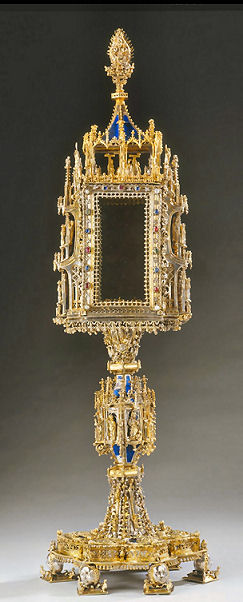 A church, with a convent and a hospital, was founded here in 1316 by Giacomina Scorpioni from the Benedictine convent of San Lorenzo d'Ammiana in the northern part of the Lagoon. Between 1460 and 1480 it was rebuilt. In the 16th century the complex passed to Augustinian nuns. Following suppression in 1805, and the demolition of the monastic buildings, it was used by the army to store animal fodder, then as a railway company warehouse in the 20th century when it still had its partly restored 'ancient roof of sprung beams', according to Lorenzetti. The church is now a very clean brick box in between a road and a dockside car park. It seems to have had all the life scrubbed off the exterior, leaving nice warm-coloured brickwork but very little character. It is now sometimes used as a Biennale venue. Lost art A bas relief of Santa Marta surrounded by nuns which was taken from above the door here is now in Angelo Raffaele, and another from the door of the convent went to Sant'Eufemia over on Giudecca. An exuberant reliquary (see right) made for the convent here, which contained the hand of Santa Marta, is now in the Louvre. It was commissioned in 1472 by the then abbess Orsa Zorgi from the silversmith Giovanni Leon, known in his native Germany as Hans Löwe. Campanile Demolished in 1910. The de' Barbari map (see right) shows a tower 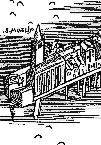 topped by a conical
spire with four pinnacles, as does the old postcard (see far right). In the Canaletto night painting
and both the Guardis, mentioned below, the campanile
has a dome. topped by a conical
spire with four pinnacles, as does the old postcard (see far right). In the Canaletto night painting
and both the Guardis, mentioned below, the campanile
has a dome.Local colour A famous fair, celebrated on the eve the Feast of Saint Martha in August, involved fishermen roasting sfogi (flatfish) on the beach, dancing, and the mingling of the classes. There is a Canaletto painting of this fair, La Vigilia di Santa Marta, in the Gemäldegalerie in Berlin (see the hastily-snapped dark detail photo right). It is one of only two known Canaletto night-views, the other being La Vigilia di San Pietro, also in the same gallery. The church in art Apart from the rare Canaletto night view mentioned above there's a painting called The Giudecca Canal with the Church of Saint Martha (see below right) by Francesco Guardi from c.1770/80 in the Gulbenkian Museum in Lisbon. Also the Victoria and Albert Museum in London has a similar painted view by Giacomo Guardi, the son of Francesco, from the beginning of the 18th century. Luigi Querena painted Santa Marta at Sunset in 1859 (see below). He being the son of Lattanzio, the restorer, and painter of many altarpieces for Venetian 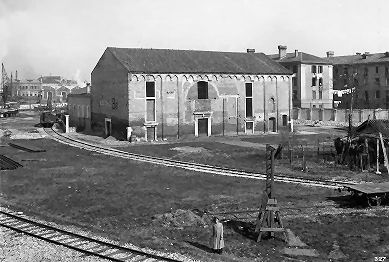 churches.
churches.There's a watercolour in a sketchbook by Turner from 1840 in the Tate Gallery's collection called Moonrise: Santa Marta with San Secondo beyond. Opening times Closed (but sometimes used as a theatre venue and/or art gallery during the Biennale.) Vaporetto Santa Marta map
A photo taken in 1934. |
|
|
|
Interior
Vaporetto
San Basilio |
||
|
Spirito Santo |
||
|
History The church and its Augustinian convent were founded in 1483 by Maria Caroldo, who became it's first abbess, with the help of her brother Jerome and a priest called Giacomo Zamboni. The church was rebuilt in 1506 to a design by Antonio Abbondi (known as Lo Scarpagnino). The Scuola to the right of the church (with a façade looking very similar but less squashed) was also added in 1506. In 1520 the Zattere fondamenta was built and the old church's apse was demolished. As a result the orientation was reversed and the present Lombardesque façade built. It was finished in 1524 by Giacomo de Bernardis, under Scarpagnino's supervision. It was here that the murderers of Lorenzino de'Medici took refuge after attacking him outside the church of San Polo in 1548. Suppressed in 1806, but reopened a few years later. The convent became a school, the Scuola became a tobacco warehouse and then a private residence, with the church presumably stripped of all art and fittings. Or so I had no reason to doubt, until I was sent some hastily-taken interior photos in March 2020 (see right) by Caroline, the wife of the author of my quote in The church in fiction below, who even got shouted at for her trouble. They show the church used as storage, probably by the local art school, but not at all stripped and bare. The interior The interior is reported to be very redolent of 200 years of restoration, with an aisle-less nave, 18th-century side altars, and a baroque high altar with Solomonic columns. The inner façade is taken up with a funerary monument to Paolo Paruta, an historian of the Venetian Republic who died in 1598, said to be by Longhena and built around 1651. His son Marco, who died in 1629, and brother Andrea, who died in 1622, are buried here too. All of which is born out by the 2020 photographs where the three busts on the monument are visible. Art highlights 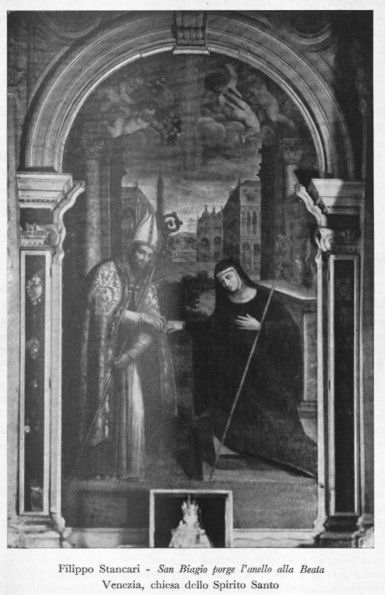 The church was said to contain altarpieces by Buonconsiglio (Jesus Between Saints Jerome and George (see Lost art below) and Saint Gregory Enthroned with Angels), Jacopo Guarana (Saint Matthew), Francesco Migliorini (The Resurrection and The Ascension), Filippo Stancari (The Marriage of the Virgin and The Blessed Giuliana di Collalto Receives the Abbey Ring from San Biagio) (see postcard right) and Jacopo Bassano, mostly from other closed churches. But given that the much more obscure painting mentioned first below is now in the Accademia, I always doubted that any of these works were still to be found here. But the 2020 photos show altars and altarpieces still in situ. Of the two side altars on the left in the photo (below right) the left-hand one looks like Filippo Stancari's Blessed Giuliana di Collalto which, given she founded the place, must surely have come from Santi Biagio e Cataldo on Giudecca. The second altar looks like a Virgin and Child in Glory, with a couple of saints maybe, and a putto. Lost art The Pentecost by Polidoro da Lanciano, an assistant to Titian, is now in the Accademia. As is the work by Giovanni Buonconsiglio, a sacra conversazione showing Christ the Redeemer with Saints Jerome and Liberalis of Treviso (San Liberale in Italian), but it's reportedly in a poor state. The nearby Anglican church of Saint George has a 19th century copy with Saint Liberalis transformed into Saint George, with Liberalis's usual flag of a white cross on a red background changed to the red-on-white of Saint George. To further muddy the waters a Buonconsiglio high altarpiece is said to have come here in 1523 when the church and convent of San Secondo closed and the nuns moved to Giudecca. This work, dated to about 1505, showed Saints Erasmus and Secundus flanking Christ. These two works may well be one and the same. The church in art 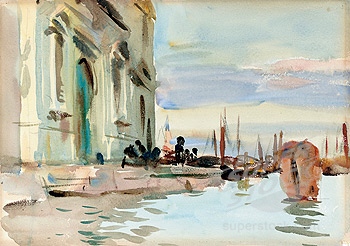 Venice from the Giudecca, San Giorgio Maggiore to the Right by (the circle of) Johan Anton Richter shows Spirito Santo and it's scuola to the left. Five watercolours by John Singer Sargent 1902-4 and one by his sister. This watercolour (see right) was once owned by William James, the son of William Sr and nephew of Henry, it having been given to him by Sargent's sister.
Disobedient nuns
|
|
|
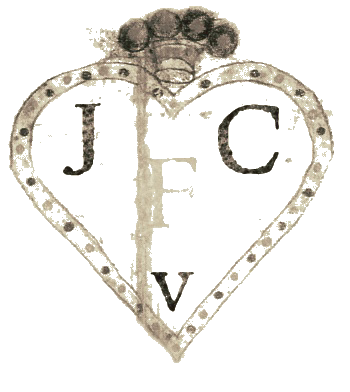
Home
Cannaregio ::
Castello :: Dorsoduro ::
Giudecca :: San Marco ::
San Polo :: Santa Croce
:: The Islands :: Demolished